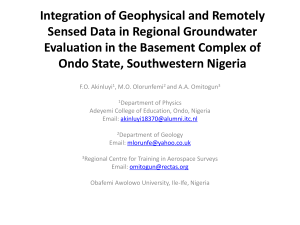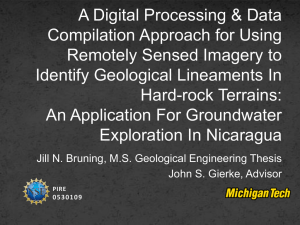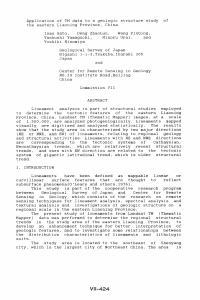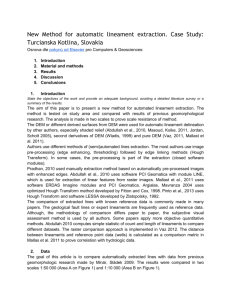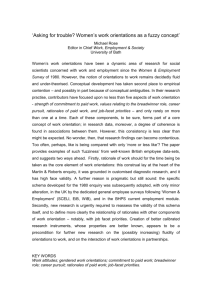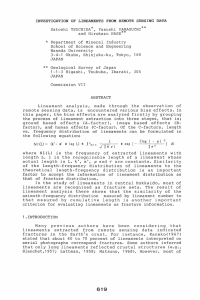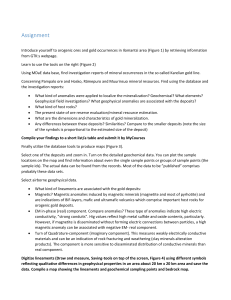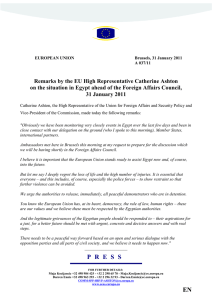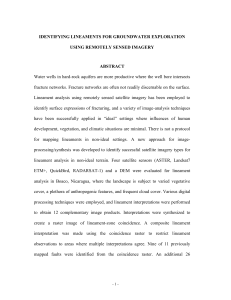Michelle_Stempel - Colorado Space Grant Consortium
advertisement
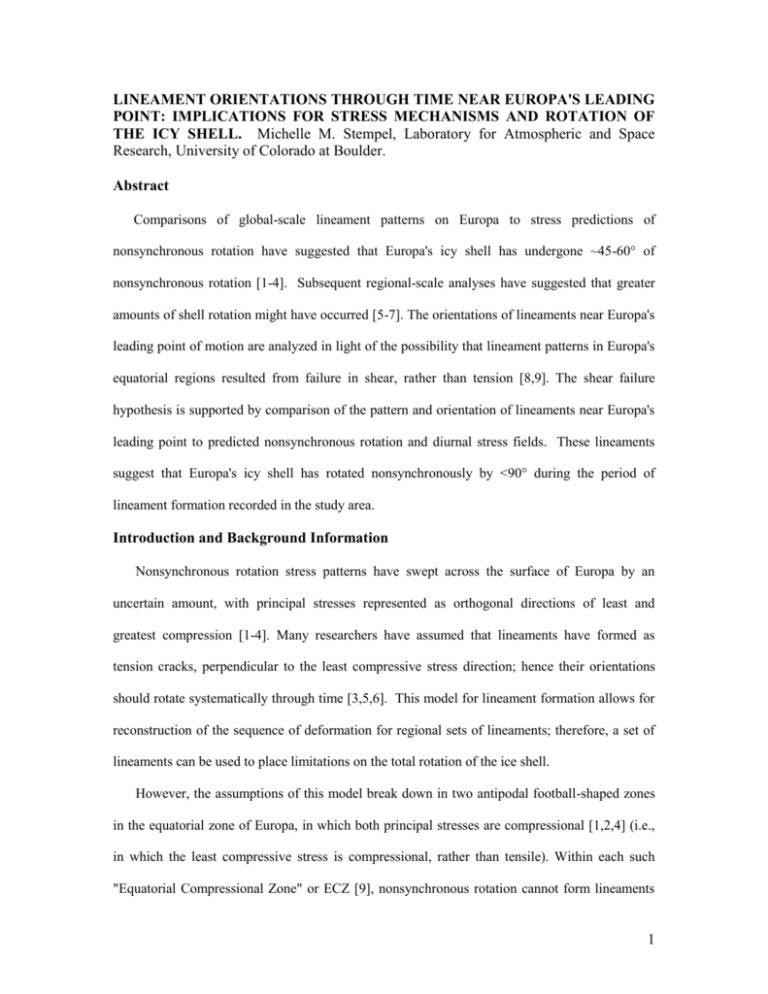
LINEAMENT ORIENTATIONS THROUGH TIME NEAR EUROPA'S LEADING POINT: IMPLICATIONS FOR STRESS MECHANISMS AND ROTATION OF THE ICY SHELL. Michelle M. Stempel, Laboratory for Atmospheric and Space Research, University of Colorado at Boulder. Abstract Comparisons of global-scale lineament patterns on Europa to stress predictions of nonsynchronous rotation have suggested that Europa's icy shell has undergone ~45-60° of nonsynchronous rotation [1-4]. Subsequent regional-scale analyses have suggested that greater amounts of shell rotation might have occurred [5-7]. The orientations of lineaments near Europa's leading point of motion are analyzed in light of the possibility that lineament patterns in Europa's equatorial regions resulted from failure in shear, rather than tension [8,9]. The shear failure hypothesis is supported by comparison of the pattern and orientation of lineaments near Europa's leading point to predicted nonsynchronous rotation and diurnal stress fields. These lineaments suggest that Europa's icy shell has rotated nonsynchronously by <90° during the period of lineament formation recorded in the study area. Introduction and Background Information Nonsynchronous rotation stress patterns have swept across the surface of Europa by an uncertain amount, with principal stresses represented as orthogonal directions of least and greatest compression [1-4]. Many researchers have assumed that lineaments have formed as tension cracks, perpendicular to the least compressive stress direction; hence their orientations should rotate systematically through time [3,5,6]. This model for lineament formation allows for reconstruction of the sequence of deformation for regional sets of lineaments; therefore, a set of lineaments can be used to place limitations on the total rotation of the ice shell. However, the assumptions of this model break down in two antipodal football-shaped zones in the equatorial zone of Europa, in which both principal stresses are compressional [1,2,4] (i.e., in which the least compressive stress is compressional, rather than tensile). Within each such "Equatorial Compressional Zone" or ECZ [9], nonsynchronous rotation cannot form lineaments 1 as tension cracks. While diurnal stresses can be tensile in the ECZs, the orientation of tensile stress in these zones is limited to nearly N-S (predicted to produce E-W lineaments) and does not rotate systematically [4]. Instead, lineaments in the ECZs may form as conjugate pairs of strike-slip faults, with predicted orientations ~30° from the greatest compressional stress direction. This mechanism has been invoked to explain orientations and stratigraphic relationships of cross-cutting lineaments in the Conamara Chaos region near the satellite’s trailing point of motion [9], and it should also be applicable to the region near Europa's leading point, which has rotated in the antipodal ECZ. If conjugate fault formation has occurred, it has important implications for the amount of nonsynchronous rotation that has occurred through time. Methods Used in the Study More than 50 lineaments have been mapped near the leading point of Europa (lat 0-30°, lon ~80°) in the Galileo E15REGMAP02 observation at ~235 m/pixel [cf. 5]. This is a region predicted to be just emerging from the ECZ as carried by nonsynchronous rotation. Figure 1 shows the orientations of these lineaments in a rose diagram. Determination of a precise stratigraphy of individual Europa structures is challenging. An objective, semi-quantitative method of stratigraphy is applied to this region based on the number of times each mapped lineament is overcut and undercut by other mapped lineaments. The lineaments have been grouped into inferred stratigraphic intervals based on the number of overcuttings versus undercuttings; ambiguous intersections were not used in determining stratigraphy. Special attention is paid to the possibility of interweaving lineament orientations, which would test the theory that closely successive lineaments formed as conjugate shear fractures. Such interweaving of structural orientations (rather than systematic, incremental rotation) would be consistent with the model of nonsynchronous stress in the ECZ. Mapping of lineament orientations as a function of stratigraphic position allows for a comparison to the predictions of diurnal and nonsynchronous stresses in the ECZ. Near- 2 simultaneous formation of structures with conjugate orientations is predicted, as is a lack of N-S and E-W lineament orientations. Lineaments with more than one distinct orientation, notably the few cycloidal ridges in the region, are not currently included in the data set, as their orientation varies along their length. These structures are thought to have formed in response to diurnal stresses [10], which the results below suggest to be an unlikely model in explaining the bulk of the lineaments in the region. Results and Analysis The predicted dominant E-W orientation of lineaments if due to diurnal stress patterns is completely lacking in the mapped area (Fig. 1), suggesting that this model is of unlikely application to the majority of structures in the region. Because diurnal stresses are also about one tenth of the magnitude of nonsynchronous rotation stresses [2, 10], an inference is made that the diurnal stress model has not been significant in creation of structures in the ECZ. In each neighboring equatorial tensile zone (ETZ), E-W structural orientations are similarly expected to dominate. If the mapped region had rotated through an ETZ, significant tensile stresses should have created E-W structures. The absence of E-W structures suggests that ETZ stresses did not contribute to lineament formation in this region. This places an upper limit of ~90° of nonsynchronous rotation for the icy shell during the recognizable period of lineament formation in the mapped region. Lineament orientations (Fig. 1) do fit the predicted pattern of conjugate shears. The direction of greatest compression is N-S within the ECZ, and all stresses are predicted to approach zero as the stress pattern shifts from a tensional zone to an ECZ, and vice versa. Therefore, lineaments formed as conjugate shears are expected to be oriented at a range of angles, with the exceptions of N-S and E-W. Notable departures from to how well the result matches predictions are the youngest and oldest features mapped (a trough and band system, respectively), which cannot be easily explained by either diurnal or nonsynchronous stress patterns. 3 Some evidence is found for NE-NW interweaving of lineaments based on our semiquantitative stratigraphy, which may support the hypothesis of near-simultaneous or successive lineaments formed as conjugate shear fractures. A truly quantitative analysis requires use of Global Imaging System (GIS) programming techniques to confidently determine whether a successive interweaving of individual lineament orientations is present in the region. Predicted differential stress magnitudes in the ECZ [4] are sufficient to cause failure in shear if lithospheric strength is frictionally controlled. Figure 1: The average orientation of each of the 46 mapped lineaments is depicted. Note the distinct lack of N-S and E-W orientations, consistent with formation of structures within an equatorial compressional zone. Conclusions and Suggestions for Future Work The stratigraphy of lineaments near Europa's leading point has been reevaluated, based on the hypothesis that lineaments in the ECZ may form as conjugate shears. Comparison of observed lineament orientations and stratigraphy is a good match to the nonsynchronous stress model predictions and a poor match to the predictions of diurnal stressing. This study yields an upper limit of ~90° for the amount of nonsynchronous rotation that has occurred during the period of lineament formation recorded in the study area. This is significantly less rotation of the icy shell 4 than some recent interpretations [5-7], but consistent with earlier studies [1-4]. We infer that the bulk of Europa's recognizable surface deformation may have occurred during finite nonsynchronous rotation of the ice shell, rather than multiple rotations. The hypothesis that fractures can form as conjugate shears in ECZs will continue to be tested through generation of a quantitative GIS-based stratigraphy for this and other equatorial regions of Europa. With such increase in precision, lineaments will no longer need to be placed into inferred stratigraphic levels based on how often they are overcut and undercut, but instead can be placed individually into an overall stratigraphy for the region. This will allow for an accurate analysis of potential patterns of interweaving fractures, which would lend support to the hypothesis being tested, if found. Development of a computer simulation of the diurnal and nonsynchronous stresses on the surface of Europa will also eventually be useful in pursuing this hypothesis, as matching lineament orientation with principal stresses back through time will aid in determining a precise sequence of lineament formation. References: [1] McEwen, A. S., Nature 321, 49-51, 1986. [2] Leith, A. C., and W. B. McKinnon, Icarus 120, 387-398, 1996. [3] Geissler, P. E. et al., Nature 391, 368-370, 1998. [4] Greenberg, R. et al., Icarus 135, 64-78 (1998). [5] Figueredo, P. M. and R. Greeley, JGR 105, 22,629-22,646, 2000. [6] Geissler, P. E., et al., LPSC XXX, #1743 , 1999. [7] Hoppa, G. V., et al., Icarus 153, 208-213, 2001. [8] Helfenstein, P and E. M. Parmentier, Proc. LPSC 11th, 1987-1998, 1980. [9] Spaun, N. A., et al., Evidence for shear failure in forming near-equatorial lineae on Europa, JGR, in press. [10] Hoppa G. V., et al., Science 285, 1899-1902, 1999. 5
